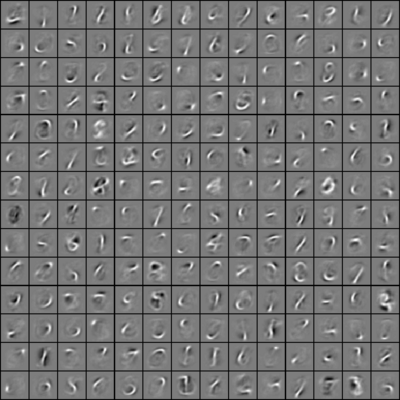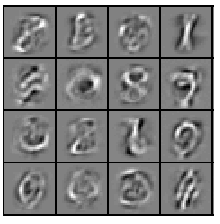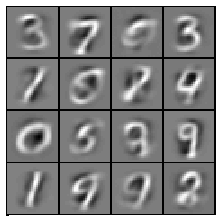机器学习向量化练习
在先前的练习里面,我们已经通过对自然图像完成了一个稀疏自编码的练习。在这次我们将通过向量化来使我们运行速度更快,并且我们将把它应用到手写数字里面。
数据下载
- MNIST Dataset (Training Images)
- MNIST Dataset (Training Labels)
- Support functions for loading MNIST in Matlab
第一步:向量化你的稀疏自编码
这一步我已经完成,具体可以看我上一次的博客。
第二步:学习手写数字的特征
1.我们先把train-images-idx3-ubyte.gz和mnistHelper这个两个文件先解压开,然后把文件放到我们上次的稀疏自编码的地方。
2.接下去我们就需要进入上次我们图片采样sampleIMAGES.m的地方,并把代码改成
function patches = sampleIMAGES()
% sampleIMAGES
% Returns 10000 patches for training
%load IMAGES; % load images from disk
%use mnist data
patchsize = 28; % we'll use 8x8 patches
numpatches = 10000;
% Initialize patches with zeros. Your code will fill in this matrix--one
% column per patch, 10000 columns.
patches = zeros(patchsize*patchsize, numpatches);
%%---------- YOUR CODE HERE --------------------------------------
% Instructions: Fill in the variable called "patches" using data
% from IMAGES.
%
% IMAGES is a 3D array containing 10 images
% For instance, IMAGES(:,:,6) is a 512x512 array containing the 6th image,
% and you can type "imagesc(IMAGES(:,:,6)), colormap gray;" to visualize
% it. (The contrast on these images look a bit off because they have
% been preprocessed using using "whitening." See the lecture notes for
% more details.) As a second example, IMAGES(21:30,21:30,1) is an image
% patch corresponding to the pixels in the block (21,21) to (30,30) of
% Image 1
%select 2000 patches from image1
%select 2000 patches from image2
%.....
% for k=1:4
% for i=1:50
% for j=1:50
% patch=IMAGES(8*i-7:8*i,j*8-7:8*j,k);
% patches(:,2500*(k-1)+50*(i-1)+j)=reshape(patch,64,1);
% end
% end
% end
images = loadMNISTImages('train-images-idx3-ubyte');
patches=images(:,1:10000);
然后接着再进去train.m文件
把模型的参数改成这样
visibleSize = 28*28; % number of input units
hiddenSize = 196; % number of hidden units
sparsityParam = 0.1; % desired average activation of the hidden units.
% (This was denoted by the Greek alphabet rho, which looks like a lower-case "p",
% in the lecture notes).
lambda = 3e-3; % weight decay parameter
beta = 3; % weight of sparsity penalty term
%%---------------------------------------------------------------
% For the autoencoder to work well we need to normalize the data
% Specifically, since the output of the network is bounded between [0,1]
% (due to the sigmoid activation function), we have to make sure
% the range of pixel values is also bounded between [0,1]
patches = normalizeData(patches);
end
%% ---------------------------------------------------------------
function patches = normalizeData(patches)
% Squash data to [0.1, 0.9] since we use sigmoid as the activation
% function in the output layer
% Remove DC (mean of images).
patches = bsxfun(@minus, patches, mean(patches));
% Truncate to +/-3 standard deviations and scale to -1 to 1
pstd = 3 * std(patches(:));
patches = max(min(patches, pstd), -pstd) / pstd;
% Rescale from [-1,1] to [0.1,0.9]
patches = (patches + 1) * 0.4 + 0.1;
end
然后其他的参数不变。
接着我们就可以运行train了。
最后,在400次迭代后,你的稀疏自编码应该学会了笔画特征。换句话说,我们的程序将会学习图片里面的笔画的特征。我们在程序结束后可以看到这样一幅图
如果你的自编码是有问题的,那你可能得到以下的图
如果你的图片像这样,请你检查你的代码和参数。



)
)

)






)

)



)

)
)